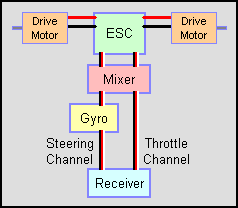Two-wheeled combat robots have many advantages: simplicity of construction, high spin rate, fantastic maneuverability, and weight savings. Perhaps their greatest problem is their instability in a straight line – they just don’t wanna go where you point them!
History

A similar problem is associated with remote controlled model helicopters. These flying head-choppers have always been difficult to control. In the 1970’s helicopter pilots first started installing electro-mechanical gyroscopes in their models to sense the rate at which their aircraft rotated and to send signals to the tail rotor servo that kept them pointed where they wanted.
By the late 1980’s, modelers had begun to construct all solid-state devices using piezoelectric accelerometers to sense rotation. These became known as ‘piezo gyros’. With no moving parts they are lighter (less than an ounce), less expensive, faster, and more robust. Just what we need for a two-wheeled robot!
Gyro Types
There are two types of piezo gyros offered: ‘heading hold’ gyros and ‘rate’ gyros. What type of gyro do you need for your ‘bot?
-
A heading hold gyro (sometimes called a 'tail lock' gyro) keeps
track of rotation to sense how far and how fast it has turned. It also tracks how much steering
input has been received from the radio system. If the two don’t match up, it sends a direction
change signal to the servo or steering mixer to correct the turn rate and keeps sending it until
the correct heading is regained. This can be awkward when the robot tries to recover from a big
hit that sent it spinning thru the air.
-
A rate gyro compares rotation to steering input and modifies the steering
signal to keep the rotation rate constant. It does not try to restore the direction the robot was
headed before a hit, so recovery is faster -- but it lacks the 'on rails' feel of the heading hold
gyro can give.
A few piezo gyros, like the 'Futaba GY4400' allow you to select either 'heading hold' or 'rate' so you can try both options and pick the one you like.
Example
You attempt to accelerate across an arena with a two-wheeled remote control combat robot. One wheel gets a little too much power or traction and the 'bot veers to one side. In spite of your best driving efforts, you repeatedly over or under correct and zig-zag across the arena, completely missing your opponent. With a heading hold gyro installed, any unintended direction change would be instantly sensed and corrected – straight as an arrow! You can also hold a smooth constant-rate turn, rather than the common 'point and shoot' driving style.
Tips and hints
-
 The 'gyro' itself exerts no physical turning force on the robot. It acts by modifying the steering signal from the radio receiver. The gyro plugs into the steering channel of your radio receiver, and the steering servo, on-board mixer, or mixer-equipped motor controller plugs into a port on the gyro.
The 'gyro' itself exerts no physical turning force on the robot. It acts by modifying the steering signal from the radio receiver. The gyro plugs into the steering channel of your radio receiver, and the steering servo, on-board mixer, or mixer-equipped motor controller plugs into a port on the gyro.
-
Note: A gyro is not compatible with transmitter channel mixing or two-stick tank steering. If your two-channel motor controller includes mixing you're all set, or you can buy a stand-alone mixer to plug in between the gyro and your controllers for single-stick control.
-
An invertible tank-steer robot needs a gyro that can be shut down via a spare radio channel. A gyro will send reversed steering correction signals when flipped upside-down, but an inverted tank-steer 'bot retains normal steering response. The result is an uncontrollable 'death spin'. A mixer with an 'invert' function corrects the forward / backward reversal but will not cure the death spin; you must shut down the gyro.
-
Four-wheeled 'bots usually have no trouble maintaining a straight line, but carving a smooth turn can be a challenge. A gyro can assist 'bots with four or more wheels in maintainig a nice, constant rate turn.
-
Piezo gyros have a tendency to ‘drift’ with temperature changes and loose track of which way ‘straight’ is. Keep your gyro away from fluctuating temperatures like chilly CO2 supplies and hot motors / controllers.
Questions?
I'll be happy to discuss piezo gyros with robot builders. My email is: joerger@toast.net
 Run Amok Combat Robotics
Run Amok Combat Robotics

 The 'gyro' itself exerts no physical turning force on the robot. It acts by modifying the steering signal from the radio receiver. The gyro plugs into the steering channel of your radio receiver, and the steering servo, on-board mixer, or mixer-equipped motor controller plugs into a port on the gyro.
The 'gyro' itself exerts no physical turning force on the robot. It acts by modifying the steering signal from the radio receiver. The gyro plugs into the steering channel of your radio receiver, and the steering servo, on-board mixer, or mixer-equipped motor controller plugs into a port on the gyro.
